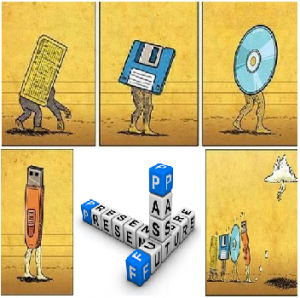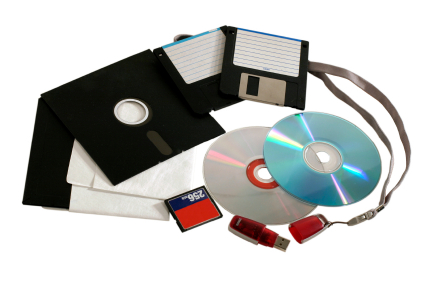Data Storage: The Past, Present And The Future!

Today, you can find desktops equipped with hard-drives capable of storing nearly 4 terabytes of data, which is more than enough for any hardcore computer geek. Considering the pace at which data storage capacity is growing, it is estimated that by 2020, hard-drives capable of storing up to 60 terabytes will be available for the average consumer. There are many examples of how quickly the dynamics of data storage have changed — the following are some great examples of the changing dynamics of data storage capacities and changing technologies – which may surprise you!
Micro SD card: 128 MB to 128 GB in less than a decade:
To further explain the massive growth of data storage in practical terms, if you can recall that in 1995 – when the first micro SD card was available for consumers, it only had a maximum capacity of 128 megabytes. Fast forward to 2014, you can now purchase a micro SD card capable of storing up to 128 gigabytes of data which truly gives you the scope on the advancement of data storage technology.
Hard disks became more compact with more storage capabilities and speed:
Today, hard-drives are more compact than they were in 1956, capable of storing only 5 megabytes at maximum – this was the first time when hard-disks were invented – surprisingly, they also weighed a couple of hundred pounds. Today, a four terabyte hard-disk usually weight less than a pound – which is quite an amazing feat.

Corporate data storage devices:
Back in 1991, your average company server was only capable of storing 2 gigabytes of company data with a scanty 256 megabytes of RAM. Today, you can purchase a company server, capable of storing up to 2 petabytes of data with 128 gigabytes of RAM.
Changes in portable data storage devices:
If you were familiar with 1970’s computer technology, you would know how 200 Megabytes disks looked liked (think of tire that weighs around 10 pounds). What’s even more astounding was the fact that it transferred data at a rate of 50 KB per second – painfully slow by today’s standards. Today, a 512 gigabyte flash drive weights only a few ounces and can fit comfortably into your pockets.
Evolution of solid state drives:
1996 was when the solid state drive first became commercially available – at that time you could purchase an SSD with the capacity to hold a whopping 40 megabytes – a mere drop in the bucket by today’s standard. Today, you can find a solid state drive capable of storing 960 gigabytes of data.
Word of caution:
Growing capacities and speed of data storage is not necessarily a good thing. In fact, with growing capacities come mounting concerns about theft of data. It’s a natural phenomenon – the more data there is, the better the likelihood of that data being stolen – with the most vulnerable being external storage devices, as they are most prone to theft and loss. Users can ensure the security of their external data by protecting their storage devices which can secure USB drives through password-protection.
Future Of Data Storage
The future of data storage is expected to be increasingly digital, with cloud-based storage becoming more commonplace. This will allow for increased scalability and security, as well as easier access to data. Additionally, the use of Artificial Intelligence (AI) and Machine Learning (ML) will be used to identify patterns in data and automate tasks. As technology advances, the capacity and speed of data storage will also improve.
Changing In Data Storage Over The Years
Data storage has changed significantly over the years as technology has advanced. In the past, data was stored in physical devices such as floppy disks, hard drives, and tapes. Now, data is stored digitally on computers and servers, allowing for much larger storage capacity and faster access. Additionally, cloud-based storage has become increasingly popular, allowing for data to be stored and accessed from anywhere in the world. Furthermore, AI and ML have been used to automate tasks and identify patterns in data, making data
Data Storage In Olden Days
These physical devices stored data in a variety of formats, including magnetic and optical media. Data was also stored on punched cards, which were used to store and retrieve data in a systematic way. Additionally, data was sometimes stored on paper, such as in the form of handwritten notes or printed documents.
Types Of Data Storage
The three main types of data storage are:
1. Magnetic Storage: This type of storage uses magnetic media such as hard drives and tapes to store data.
2. Optical Storage: This type of storage uses optical media such as CDs, DVDs, and Blu-ray discs to store data.
3. Flash Memory: This type of storage uses flash memory chips such as USB flash drives and SD cards to store data.
Introduction To Data Storage System
Data storage system is a system that stores and manages data. It includes hardware, software, and other components that work together to store, organize, and manage data. Data storage systems can be used in a variety of applications, ranging from personal computers to large enterprise systems. They are used to store and manage data for a variety of purposes, including data analytics, backup and recovery, archiving, and more.
Importance Of Data In Future
Data is important in the future because it will help drive decision-making, improve operations, and create new opportunities. Data can provide insights into customer behavior, help businesses optimize their processes, and inform decisions about products and services. Additionally, data can be used to create predictive models and to analyze trends. Data can also be used to create personalized experiences for customers, as well as to develop new products and services. Finally, data can be used to improve customer service, reduce costs, and increase efficiency
Modern Methods Of Storage
Modern data storage methods include cloud storage, solid state drives, hard disk drives, optical storage, and more. Cloud storage is a popular method of data storage, as it allows users to access data from anywhere with an internet connection. Solid state drives are also popular, as they are faster and more reliable than traditional hard disk drives. Optical storage is another popular option, as it is cost-effective and provides high
Storage Devices Evolved In The Last 50 Years
In the last 50 years, storage devices have evolved from magnetic tape drives to hard disk drives, optical drives, and solid-state drives. Magnetic tape drives were the earliest form of storage, but they were slow and unreliable. Hard disk drives replaced magnetic tape drives, offering faster access and more reliable storage. Optical drives emerged in the late 1980s, providing a cost-effective way to store large amounts of data. Finally, solid-state drives emerged in the early 2000s, offering faster.
